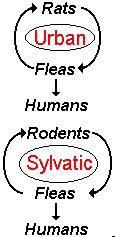|
Yersinia
ORGANISM:
- Genus: Yersinia
- Species: pestis, enterocolitica
GENERAL CONCEPTS:
- The organism Yersinia pestis is responsible for the plague, a disease that has an extremely important place in human history. During the 6th century AD, the plague ravaged the known world over a 50 year period causing 100 million deaths. The "black death" again devastated Europe during the 14th century over a 5 year period causing 25 million deaths (25% of the European population).
- Other species of Yersinia generally produce a self-limiting gastroenteritis.
DISTINCTIVE PROPERTIES:
- The genus Yersinia is composed of Gram negative, bipolar staining coccobacilli. Like other Enterobacteriaceae, their metabolism is fermentative. Y. pestis produces a thick anti-phagocytic slime layer, while Y. enterocolitica is motile at 28°.
PATHOGENESIS:
- Plague is a disease that is primarily maintained among rodent populations and transmitted by infected fleas. Urban plague involves rats and has been the major source for human epidemics. Sylvatic plague exists in wild rodent populations.
- Two distinct forms of plague occur in human populations:
- Bubonic plague occurs within a week of being bitten by an infected flea. Multiplication of the bacteria produces the characteristic "bubo" (swollen, painful lymph node). Bacteremia follows, causing death in about 75% of those affected.
- Pneumonic plague occurs under crowded conditions when contaminated respiratory droplets expelled by infected persons are directly inhaled by another person. This form is characterized by a shorter incubation period and greater mortality (90%).
- Pathogenic Y. pestis produce two antiphagocytic components; F1 antigen and the VW antigens. Both are required for virulence and, interestingly, are only produced when the organism grows at 37°, not at lower temperatures. This might explain why the bacteria are not virulent in their alternate host, the flea, which has a body temperature near 25°. Moreover, the bacteria are capable of surviving and multiplying within monocytes, but not PMNs, and upon emerging from the monocytic host, the bacteria possess their F1 and VW antigens.
- Most disease produced by Y. enterocolitica is a typical gastroenteritis characterized by fever, abdominal pain, and diarrhea. Illness generally lasts from 1 to 2 weeks but chronic cases may persist for up to a year.
HOST DEFENSES:
- Antibodies specific for the F1 and VW antigens are opsonic and confer immunity by enhancing phagocytosis and intracellular killing by PMNs.
EPIDEMIOLOGY:
- Plague occurs in urban or wild rodent populations: humans acquire disease primarily via infected fleas. The Yersinia multiply in the flea intestinal tract. Upon biting a new host, the flea regurgitates, inoculating the new host with the organisms.
- Y. enterocolitica is an intestinal parasite of animals. Humans acquire disease via ingestion of contaminated food or water.
DIAGNOSIS:
- Clinical: Rapid diagnosis must be made because of the speed at which the disease progresses and the high mortality rate. Bubonic plague can result in 75% mortality with a few days; the pneumonic form can result in greater than 90% mortality within 24 hours. Diagnosis of Yersinia gastroenteritis requires laboratory confirmation.
- Laboratory: Examination of sputum or a lymph node biopsy will reveal Gram-negative, bipolar staining coccobacilli. However, for the safety of workers and the community, P-3 level containment is required for Y. pestis. Y. enterocolitica may be grown on a variety of standard bacteriologic medias.
CONTROL:
- Sanitary: Control of rat populations concurrent with elimination of their fleas prevents spread of the plague to humans. Decontamination of water and milk prevents gastroenteritis.
- Immunological: A short term vaccine against Y. pestis is available for persons at high risk.
Chemotherapeutic: Treatment of the plague must be rapid and aggressive. Y. pestis is generally susceptible to streptomycin and chloramphenicol but concomitant therapy is sometimes recommended. Treatment of Y. enterocolitica infections usually involves the use of ampicillin or tetracycline.
|
|